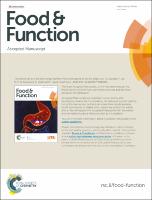Please use this identifier to cite or link to this item:
https://repositorio.usj.es/handle/123456789/1051
| Title: | Anthocyanin profile, antioxidant activity and enzyme inhibiting properties of blueberry and cranberry juices: a comparative study (accepted version) |
| Authors: | Casedas, Guillermo


Les Parellada, Francisco 

López Ramos, Víctor 

Gómez-Serranillos, M. Pilar 

Smith, Carine 

|
| Keywords: | Blueberry; Cranberry; Ericaceae; Anthocyanin; Diabetes; Neuroprotection |
| Issue Date: | 2017 |
| Publisher: | Royal Society of Chemistry |
| Citation: | G. Casedas, F. Les, M. P. G-Serranillos, C. Smith and V. López, Food Funct., 2017, DOI: 10.1039/C7FO01205E. |
| Description: | Cranberry (Vaccinium macrocarpon) and blueberry (Vaccinium myrtillus) juices are commonly consumed as a source of antioxidants. The aim of this study was to compare bioactivities as well as the differences in the polyphenol content and anthocyanin profile of both juices. Polyphenol and anthocyanin contents were quantified using pectrophotometric and chromatographic methods. Bioassays were carried out in terms of antioxidant properties in cell and cell free systems as well as inhibition of physiological enzymes that are targets involved in the prevention of chronic diseases (monoamine oxidase A, tyrosinase, acetylcholinesterase, α-glucosidase and dipeptidyl peptidase-4). Both juices contained a significant amount of anthocyanins (3.909 mg anthocyanins per mg extract for blueberry juice and 0.398 for cranberry juice) and also exhibited a antioxidant properties against DPPH, superoxide radicals and hydrogen peroxide. These juices showed inhibitory effects on the enzymes, showing substantial potential as antioxidant, neuroprotective and anti-hyperglycaemic agents. The total anthocyanin and polyphenol content was higher in blueberry juice, which is indicative of a higher antioxidant activity. Both juices were also able to inhibit monoamine oxidase A, tyrosinase, α-glucosidase and dipeptidyl peptidase-4 in a dose-dependent manner. However, cranberry juice had a greater capacity than blueberry juice as an α-glucosidase inhibitor, revealing a similar activity to acarbose. |
| URI: | https://repositorio.usj.es/handle/123456789/1051 |
| ISSN: | 2042-6496 |
| Appears in Collections: | Artículos de revistas |
Files in This Item:
| File | Description | Size | Format | |
|---|---|---|---|---|
| anthocyanin profile_2017.pdf | 1,24 MB | Adobe PDF |  View/Open |
This item is licensed under a Creative Commons License

